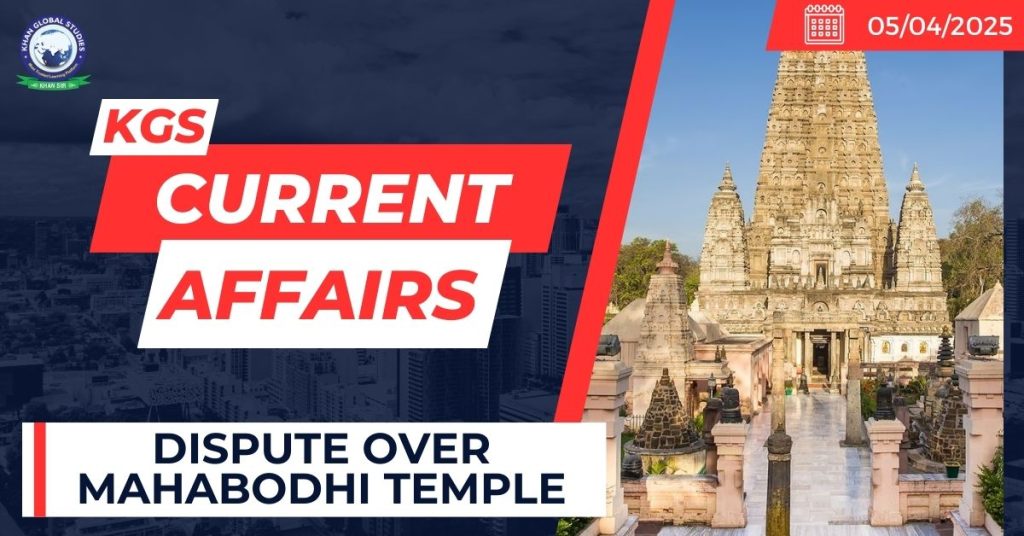Context:
Recently, the demonstrations took place demanding full Buddhist control of the Mahabodhi Temple Bodh Gaya, Bihar.
More on the news:
- These protests are the latest chapter in a decades-old dispute over who controls one of the holiest sites in Buddhism.
- Buddhists want the repeal of the Bodh Gaya Temple Act, 1949 (BGTA), under which the temple is currently governed.
About the Mahabodhi Temple Complex:
One of four Buddhist holly sites. The temple stands to the east of the Mahabodhi Tree, where Gautam Buddha is believed to have attained nirvana.
- Other three sites are:
- Lumbini- Birth Place of Buddha.
- Sarnath- From where Buddha gave first sermon
- Kushinagar- Where buddha attained Parinirvana (Passing of Buddha)
The temple was built by Ashoka in the 3rd century BCE which comprise of only the Vajrasana (Diamond Throne), a stone slab under the Bodhi tree next to the temple.
Additional structures were built during the Shunga period (2nd to 1st century BCE).
It is one of the earliest Buddhist temples built entirely in brick and still standing in India since the late Gupta period.
It is located on the bank of Niranjana river in Bihar.
The main structure comprises a 50-meter-high pyramidal shikhara with intricate engravings and arch motifs.
Four small towers surround the temple structure where each tower has been topped with an umbrella-like dome. A yellow sandstone statue of Buddha is also encased in glass box.
Fifth-century Chinese traveller Faxian (Fa Hien) wrote that there were three Buddhist monasteries around the temple in Gaya.
The current pyramidal structure can be dated to the reign of the Guptas in the 6th century CE.
The Palas (8th-12th century CE) were the last major royal patrons of the Mahabodhi temple. By the 11th-12th centuries, Buddhism was gradually declining in the subcontinent, and so were its many centres, including in Gaya.
Budget 2024 announced that corridor projects will be built for the Vishnupad Temple at Gaya and the Mahabodhi Temple at Bodh Gaya in Bihar.
These will be modelled on the successful Kashi Vishwanath Temple Corridor, to transform them into world-class pilgrim and tourist destinations.
Why Bodh Gaya Temple Act (BTA), 1949 is controversial?
The shrine was in a state of disrepair when Alexander Cunningham, the founder of the Archaeological Survey of India, began restoration in the 1880s.
According to UNESCO, which granted the Mahabodhi temple the World Heritage Site tag in 2002, the shrine was largely abandoned between the 13th and 19th centuries.
However, according to popular legend, a wandering Shaivite monk named Mahant Ghamandi Giri arrived in Gaya around 1590, and established what would become the Bodh Gaya Math, a Hindu monastery.
Giri’s descendants continue to control the Mahabodhi temple, which they say is a Hindu site.
Calls for the temple to be handed over to the Buddhists can be traced to the late 19th century.
These were initially led by the Sri Lankan monk Anagarika Dhammapala, who even took the Hindu priests controlling the Mahabodhi temple to court.
Dhammapala’s struggle culminated in the passage of the Bodh Gaya temple act (BGTA) by the Bihar Assembly in 1949, 16 years after his death.
- The BGTA provided for the creation of a committee to run the Mahabodhi temple.
- The Act says the District Magistrate of Gaya shall be the ex officio Chairman of the Committee, but adds that “the State Government shall nominate a Hindu as Chairman of the Committee for the period during which the district Magistrate of Gaya is non-Hindu”
- Though the BGTA gave Buddhists a stake in the management of the shrine the actual control remained with Hindus.
The Buddhist monks argued that Hindu rituals have gained predominance in the temple over the years.
In 2012, two Buddhist monks filed a petition before the Supreme Court seeking a repeal of the BGTA.
In addition, the case is complicated by the Places of Worship Act, 1991.
- Introduced in the wake of the Ayodhya movement, the Act provides for the maintenance of the religious character of any place of worship as it existed on August 15, 1947.
The protests began after Buddhist monks fasting against “non-Buddhist” rituals were forcibly removed from the temple at midnight on February 27.

